-
Posts
11,151 -
Joined
Content Type
Profiles
Forums
Store
Help Articles
Posts posted by slkinsey
-
-
So, I've been reading Esquire Drinks: An Opinionated & Irreverent Guide to Drinking With 250 Drink Recipes by David Wondrich (known here as Splificator). This is an attractive book, full of interesting cocktails and worthy of discussion just on that basis. It's also a fun book, with Dave's particular brand of humor coming out on every page.
One of the fun things is the "rule" that comes up on the occasional page. They're funny, but also true in the same way fortune cookie fortunes are true. A few examples are: Rule #823 - If the bartender doesn't make a decent Manhattan, that "house special" will probably suck, too. Rule #223 - Never order a drink whose name includes a part of the anatomy normally covered by underwear.
Well, today I was trying to figure out just exactly what a Splificator is (it's a drink), and googling brought me to Esquire.com where I found another list of (presumably Dave's) rules, including such gems as: Rule #1 - there is no such thing as a Chocolate Martini. Rule #54 - Unless you are lounging on the Promenade Deck, do not drink from a fruit.
My favorite: Rule #832 (book) or Rule #65 (web) - Shun novelty, suspect innovation.
So... how about coming up with some rules of our own?
-
The two things that have to be considered are: 1. how long/extensive will dinner last (which also related to the time of day it starts); and 2. how much alcohol will be consumed with dinner. These things should inform the alcoholic strength of the before-dinner cocktail.
Thanksgiving diner at the slkinsey household is a 9 course "tasting menu" that allocates close to a bottle of wine per person. It also goes from around 8:00 to around 11:00 before dessert. If I were to serve a Manhattan (several ounces of strong booze) before dinner, everyone would be asleep and/or completely shitfaced by the time the final course arrived. This is one reason I thought of making a cranberry Bellini (not, strictly speaking, a "cocktail"). Dave's drink also strikes me as a good one. It's a more traditionally cocktail-like, but it's still not going to pack too much of a kick before a big heavy dinner compared to a drink with several ounces of strong booze.
-
I'm working on my menu right now, and am thinking of serving "Cranberry Bellinis" before getting down to business. These will need to be tweaked, but my going-in thought is: homemade cranberry puree, orange bitters and prosecco. Depending on whether the cranberry puree has enough sweet balance, I may soak a sugar cube in orange bitters and put that in the drink after the puree (but before the prosecco).
-
We can definitely consider Franny's, but there are a few things prospective participants need to consider:
1. The pizzeria is very small, and has only small tables. They normally do not accommodate large groups, and so we'd have to make special arrangements -- which will increase the lead time.
2. Franny's is substantially more expensive than the other pizzerie we have visited thus far. An appetizer, individual pizza and a pint of beer will run around 38 bucks with the tip. Now, that's okay with me considering the quality of what you get... but it's something people should understand. If you're on a tight budget, Franny's may not be for you.
-
The fact is that restaurant food simply isn't all that healthy in the context of a "first world" diet. And it's not their job to make it healthy anyway. It's their job to make it taste good. What tastes good? Fat and sugar and and calories and salt. People just need to accept the fact that eating in a restaurant is not a "healthy eating experience" and understand that there is a place to eat when you are counting calories and obsessing over fat grams. That place is called your own home.
-
I was browsing around Amazon.com the other day, and happened to notice that Dr. Cocktail's new book was out. It's called Vintage Spirits & Forgotten Cocktails: From the Alamagoozlum Cocktail to Don the Beachcomber' Zombie : 80 Rediscovered Recipes and the Stories Behind Them. This is a wonderful book and a must-have for the classic cocktail enthusiast. In short, exactly what we would expect from Ted Haig.
As the title suggests (and as he points out in the introduction), "what you'll find here are recipes you'll never find in a bar or restaurant." While that's not entirely correct for every recipe if one is fortunate enough to live in a center of the cocktail renaissance like NYC, this little book serves up plenty of intriguing and unknown potables that will tickle your fancy, not to mention your tastebuds. The Jupiter Cocktail, the Coffee Cocktail (neither looks nor tastes like coffee), the Seelback Cocktail, the Pendennis Cocktail and other unknowns are featured along with a few that are more familiar to the internet cocktail crowd, such as the Aviation and the Twentieth Century Cocktail. There's even a recipe for a Ritz Sidecar that sells for 400 Euros!
All that said, it is really not accurate to describe this book as a collection of recipes or even as a bartending guide. Fundamentally it is about history and telling the story behind each cocktail. Ted Haig is known as the leading cocktail historian of the day, and his book does not disappoint. After starting with a short introduction on "cocktail archeology" -- including a very interesting section on how Prohibition led to blended whiskey, the popularity of highballs and ultimately to the dominance of vodka -- he goes right to the drinks and works a little history lesson into each one. Reading about the Golden Dawn, one learns about the United Kingdoms Bartenders Guild that flourished especially during the Prohibition years and created many distinctive cocktails (one also wonders if the drink was named after the Hermetic Order of the Golden Dawn). The recipe for the Jack Rose Cocktail leads to a discussion on Applejack, the unfairly neglected American apple brandy. And so it goes.
The book is also lavishly illustrated with pictures of antique bottles, barware and other cocktail-related items from the author's collection. It's a great read, and something every cocktail enthusiast should peruse.
-
Van Winkle rye is also outstanding.
-
While you all were at Arturo's, I went with a friend to Una Pizza Napoletana (click here for the post).
Sounds awesome. We'll have to check it out once the opening hype dies down a little.
-
My pictures are now updated with narrative upthread.
-
Just one thing, though, Sam: I'm not sure what YOU mean by "oven spring" but in baking circles, that's the rise of the dough when it initially meets the heat of the oven, iirc. Your photo is of something else --plyabilty?
Exactly. I'll expand on it when I put in the narrative, but what that picture shows is that there isn't much oven spring to speak of. When you look at the side of a spice of pizza, especially looking at the cornicione, you can see what kind of oven spring they're getting. Somewhere upthread there's a picture of a Grimaldi's slice with amazing oven spring. (BTW, there is a clickable index of Surveyed pizzerie on the first post of the thread.)
-
Had a great time. Good pizza. Made some new friends. Reacquainted myself with some old ones. Finished the day with gelato at Otto. Hard to imagine how it could have been much better.
Arturo's is an interesting place. It's an old NYC coal oven pizzeria that seems to have fallen off the radar. And it's a shame, because they make a very respectable pizza, and one that's at the very least competitive with some of their more famous colleagues. It's not as good as Patsy's East Harlem or Grimaldi's at their best, but it's certainly better than Lombardi's and competitive, I think, with Totonno.
Arturo's has a nice old-school feeling. Lots of pictures on the walls, low lighting, several small rooms, and a quirky atmosphere. They even had someone playing a grand piano in the front room. Arturo's is also distinguished by the number of interesting and unusual (for a classic NYC pizzeria) toppings they offer: capers, clams, shrimp, calamari, broccoli rape, artichoke hearts (unfortunately canned), chicken and more. Thankfully, they did not seem to offer any weird "Wolfgang Puck" toppings that would not be in keeping with a traditional NYC pizzeria. So... the pizza:
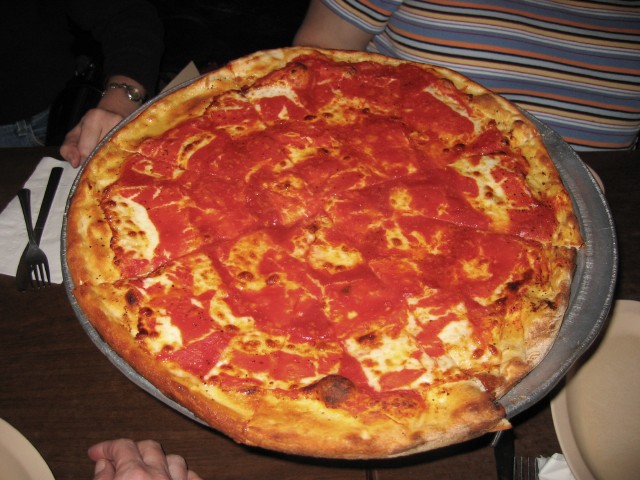
Naturally,we started off with unadorned (low moisture) mozzarella and tomato pizza. To be honest, I was expecting something fairly mediocre and this turned out to be very good. The bottom was crisp, and the toppings were flavorful. There was also a substantially thicker layer of toppings than is found on some of the other places, notably Patsy's. This, combined with their oven management, had a few consequences on the quality of the crust, which I'll discuss in greater detail below. For now, suffice it to say that Arturo's makes a good "middle ground" pizza between those like myself who prefer a sparsely topped pizza featuring the crust and those who are more interested in tasty and plentiful toppings. This is to say that the crust is good enough to appeal to a crustophile, if not outstanding, and the adornements are good enough and present in sufficient quantity to satisfy a toppings enthusiast.

Here's a look at the char on the reference standard pie. This is not bad. It's nicely browned, and with a few carbonized spots here and there. However, there is a price to be paid for those thick toppings and their oven management.
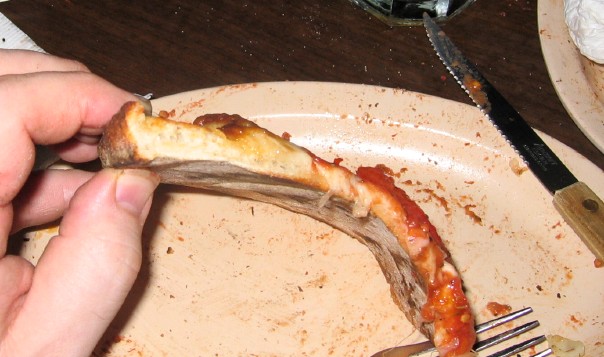
Here's a view of an Arturo's slice from the side. See the light, airy texture from the oven spring? No? Neither do I. This is due to three things:
1. I don't think the oven is really as hot as it should be. When I went into the kitchen and asked the pizzaiolo when they fired the oven, he told me they had fired it at 3:00. 3:00?! They opened their doors at 4:00 and we were eating pizza by 4:30 (along with quite a few other people). There is simply no way the oven can soak up enough heat in an hour and a half to produce that mind blowing oven spring.
2. A thicker layer of toppings weighs down the crust, inhibiting oven spring. It also means that the crust has to be a little thicker, which also inhibits oven spring.
3. As a result of the two points above, Arturo's has to cook their pizze longer. At Patsy's and Grimaldi's, the pizze hit the oven floor and come out fully cooked in around 2-3 minutes. The pizzaiolo at Arturo's told me that their pizze bake for around 10 minutes.
Oven spring is what happens when a piece of dough hits a hot oven surface. Heat from the oven surface transfers into the dough. How much heat transfers into the dough, how rapidly and how thoroughly the heat transfers into the dough depends on the temperature of the oven surface, the heat capacity (i.e., the "quantity" of heat) of the oven surface, and the thickness of the dough. A very hot oven surface that has accumulated a lot of thermal energy is able to quickly and thoroughly transfer heat into a thin piece of dough. Water in the dough turns into gas and the air in the dough rapidly expands. When that happens, the tiny air bubbles in the dough rapidly expand, combine, etc. The dough "springs up" from the oven floor, and the result is a light, airy, pliable texture. If the oven temperature is too low, or the oven floor has not accumulated sufficient heat or the pizza is too thick, this mechanism doesn't work as well. Heat is not transferred from the oven floor throughout the pizza dough with sufficient rapidity or intensity, and the result is less than spectaculat oven spring.
As you can see, the situation at Arturo's is one where the temperature of the oven, the short firing time and the weight of the toppings conspire against a strong oven spring. In addition, since they pizze must be baked for a longer period of time in order to cook through and achieve a crisp, charred bottom, the crust dries out somewhat. This is a net loss with respect to the quality of the crust. A pizza that is baked with a good oven spring in a short period of time has a crisp bottom but also has an etherial lightness and pliability -- morbidezza -- due to the airy interior created by the expansion of the crust and also to the moisture that is retained as a result of the short baking time.
Ultimately, it's all part of the tradeoff: if you're going to have heavier toppings, you're going to miss out on crust perfection. Arturo's, to their credit, does an admirable job at having one foot in each world. Happily, the end result is a pizza where you notice what is there (i.e., plenty of tasty toppings and a decent char) more than what isn't.
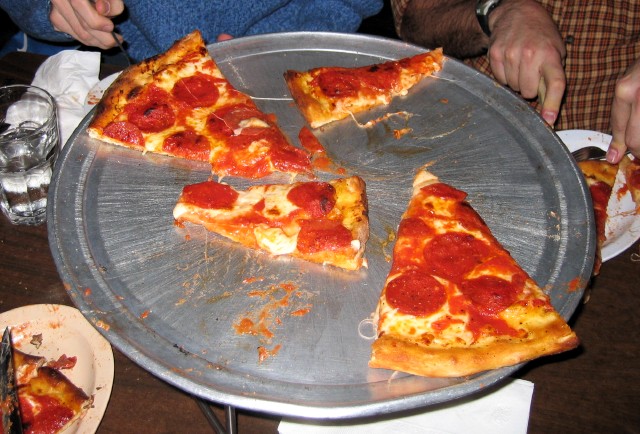
Pepperoni pizza. Those bastards tore it apart before I could take a picture.
 This, for me, was probably the post pedestrian pizza of the outing. I'm just not crazy about pepperoni, with the sole exception of Di Fara's thick-cut product.
This, for me, was probably the post pedestrian pizza of the outing. I'm just not crazy about pepperoni, with the sole exception of Di Fara's thick-cut product.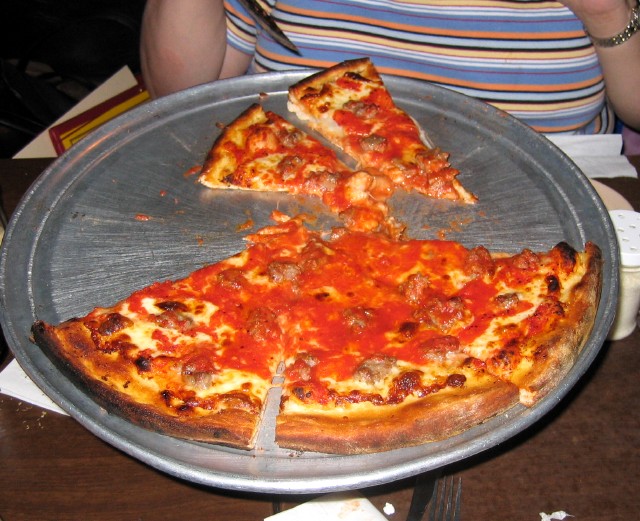
Here's a look at some of the sausage pizza. The sausage was crumbled rather than sliced, which I like. Hard to tell whether it was put on the crust raw to cook in the heat of the oven. Might have been, since it was juicy and flavorful. To-date, only Grimaldi's of the classic NYC pizzerie has better sausage.

Now we branched out into some of Arturo's more unusual offerings. This is a calamari pizza with sauce/no cheese. They put the calamari on the crust raw, and it cooks in the heat of the oven. The calamari was tender and perfectly cooked. I thought this pizza had real potential, but it was missing a few things that would have put it over the top.
As others have noted, the calamari pizza wanted salt. I salted my slice, and it was greatly improved. So it became quite clear that Arturo's uses salted mozzarella, because all the other pizze had plenty of salt. In fact, while we're talking about salt, it was also quite apparent that Arturo's uses salt in its pizza dough. This is something that I don't tend to like -- I prefer to have the salt come from the toppings or be sprinkled on -- but Arturo's made it work.
The other issue is that calamari doesn't have a great deal of flavor all by itself. The calamari pizza really could have benefitted from a dusting of parsley, maybe some extra garlic and perhaps a sprinkle of crushed red pepper. Then, I think it would have been really very interesting.

We also got a clam pizza with cheese/no sauce on the recommendation of our (very helpful and friendly) waiter. I have to admit that I was skeptical. Clams with cheese? But, as others have observed, it really worked. The subtraction of the fairly wet sauce also seemed to help the crus quite a bit. Most of us agreed that this was the best pizza of the outing, and this is the pizza I'd recommend to anyone visiting Arturo's. Infinitely better than Lombardi's unjustly famous clam pizza.

Here's our final pizza, with roasted red peppers.
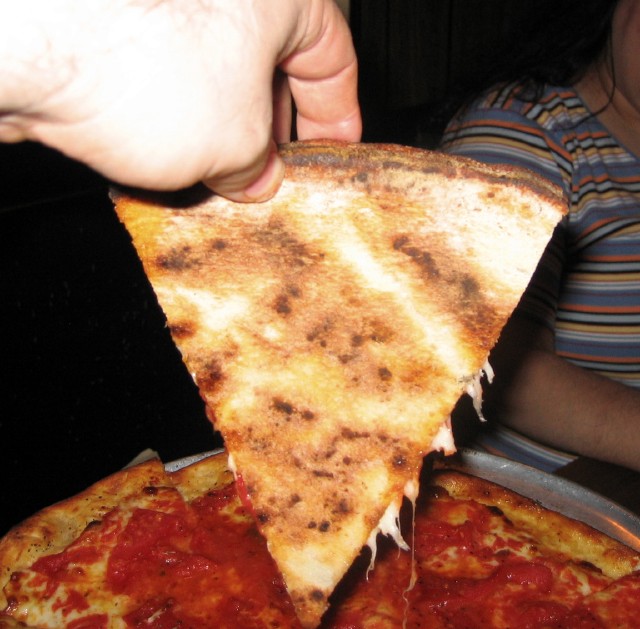
Char on the red pepper pizza. It's pretty much the same as the char on the first slice. This reflects well on their consistency and oven management. The oven isn't getting any hotter, and it isn't getting any colder either.
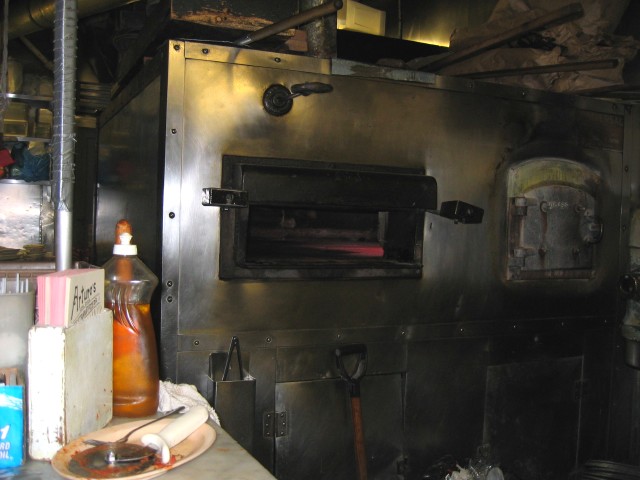
Here is Arturo's oven. It's original, dating from the 1950s.
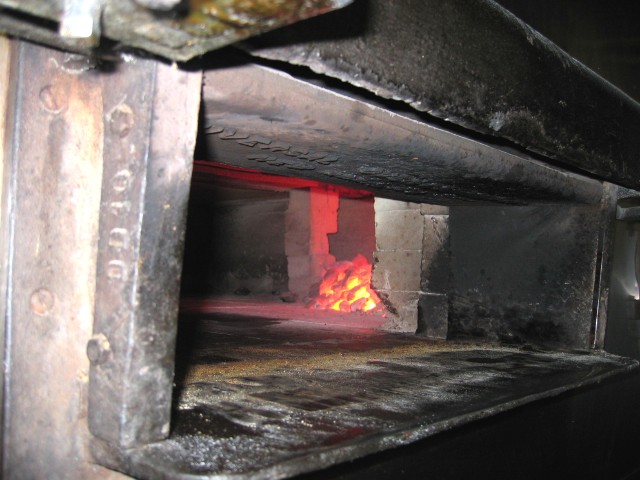
A closer look inside the oven door. Check out the pile of coals glowing over on the right.
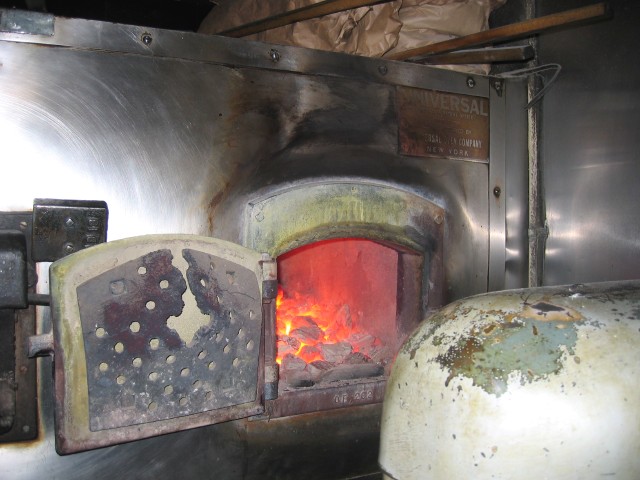
A close look at the coal pile through the coal door. This is where they load the coal. As with most of the traditional coal-fired pizzerie, the coal burns in the same chamber as the pizze are baked.

There's a chalkboard in the bathroom. We tagged it, as you can see. Had to represent, yo.
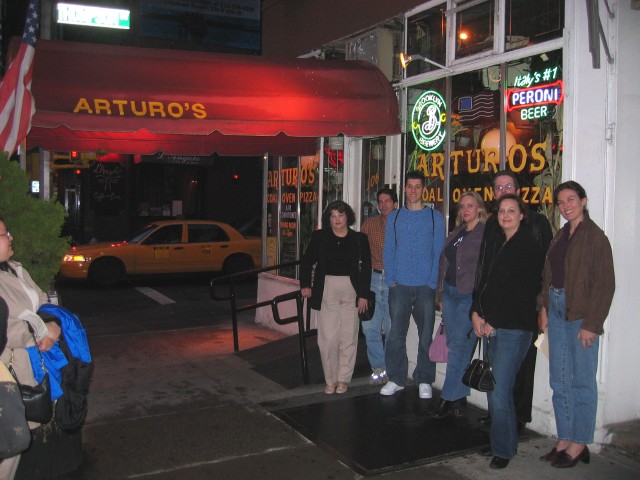
A well-fed group of eGulleters. From left to right: Rachel Perlow, JAZ, MHesse, tupac17616, SarahD, phaelon56, Jen Keenan, bergerka.
After leaving Arturo's, the close proximity of Otto and its famed gelato was too much for many of us to resist.
Thanks for coming, everyone!!
-
A NY State outfit, Stone Church Farm was recently brought to my attention. They are located in Rifton, New York in Ulster County.
They have a business raising and selling rare French "heirloom" breeds of duck, including French Pekin, Duclair and Challans or Nantais. Apparently the Challans breed (supposedly a 400-year-old breed once served to French kings) tastes like, of all things, really good beefsteak.
Anyone familiar with Stone Church Farms? Anyone tried a Challans duck?
-
My kitchen opens out into my dining room which opens up into my living room with French doors. So the kitchen counter that separates the kitchen from the dining room is where I do my mixing.
I keep the barware in a corner china cabinet in the dining room. Booze I keep in several places: most of it is in the hall closet, some is under the kitchen counter, and some is in a cabinet above the refrigerator. Glasses are in the freezer.
-
Will the commercial yeast have an effect on the sour flavor?
Polack
Yes. It will make the bread less sour. The faster the bread is leavened (and commercial yeast rises much faster than sourdough yeast) the shorter the time the lactobacilli have to produce acid.
-
And the accolades continue to come in...
Franny's was featured in the October edition of Organic Style in their list of 20 Fresh Places To Eat. Organic Style says, "the chefs steering the 20 restaurants on our list are extraordinarily passionate not only about what they serve but also about who provides it and where it comes from." About Franny's they write, "[they] have created a menu that extends far beyond traditional pizzas to snap pea and mint salad, spinach and ricotta gnocchi, and squid with white beans, chilies, and lemon."
Franny's is also featured in this month's New Yorker in the Tables for Two section. Andrea Thompson writes: "A pizzeria may seem like an unlikely place to be schooled in socially responsible consumerism, but the menu at Franny’s offers a quick course in sustainable agriculture . . . [the pizzas arrived] flopping over the edges of the plates, the crust was thin and toothsome—as crisp as a cracker on the cheeseless clam-and-chili pizza, soft but still firm under the influence of the quattro formaggi."
-
In terms of responsiveness, it would definitely make much less difference on an electric coil stove. With an electric coil stove, you are effectively limited because the heat source itself is not very responsive. A piece of cookware can only respond as fast as the heat source changes.
The one advantage a responsive material would have on an electric coil stove, and it's not clear that this is enough of an advantage to be worth the money, is that you could take the pan off the burner entirely and it would cool down quickly.
-
Updated List:
Arturo's Coal Oven Pizza - Saturday, October 16, 1:30
106 West Houston St
New York, NY 10012-2529
Phone: (212) 677-3820
Attendees
bergerka
Blondie
Jason Perlow
JAZ
Jen Keenan
MHesse
MobyP
phaelon56
Rachel Perlow
SarahD
slkinsey
Suzanne F
tupac17616
-
My mother is a fish.
(Sorry, couldn't resist)
-
Can you share the Sidecar recipe? I really like those!
From this thread:
Tantris Sidecar1 oz Courvoisier VS Cognac
1/2 oz Busnel Calvados (or other good quality)
1/2 oz Cointreau
1/2 oz Fresh Lemon Juice
1/2 oz Simple Syrup (1-1)
1/4 oz Pineapple Juice
1/4 oz Green Chartreuse
Garnish: Lemon Twist
Sugar half the rim on a martini glass. Measure all ingredients into a mixing
glass, add ice, shake well, and strain into martini glass. Garnish with a big
lemon twist.
Enjoy!
Audrey
Just mixed up a Last Word this evening for myself, bergerka and JAZ. Great cocktail. Janet and I were both struck by the way the cocktail evolved in the glass. The first sip was sweet and the maraschino came through very strongly, making us think that it wasn't balanced quite right. But both the sweetness and maraschino had married with the other flavors into something that didn't speak too strongly of any single flavor by the second sip. Indeed, every sip was a little different. Very interesting and enigmatic cocktail, somewhat evocative of the Twentieth Century Cocktail in being hard to nail down. And talk about a cool-looking drink! Great green color. I garnished ours with lime twists.
I wonder what this would be like with a touch of Pernod...
-
Do any of the copper mfgrs have saute or fry pans with both handle and loop?
No fry pans of which I am aware, but most of them include a "helper handle" on the opposite side of their 11-inch sauté pans.
-
To add my two cents:
Definitely use yellow corn meal, coarser grinds being better.
Traditionally, the best Italian polenta is cooked in an unlined copper kettle over an open fire. It is cooked for a very long time and a crust builds up on the inside of the copper vessel. This crust imparts a great deal of the toasty corn flavor. Understanding that, I would think that any crust-forming method for the home cook would be a good one. However, if you're planning on using chicken stock or milk or loading it with a lot of gorgonzola, it's probably not worth the trouble as these added ingredients will obscure the corn flavor anyway.
-
Hmmm... ths page seems to indicate that bacteria-produced rennet is okay, in which case there should be no barriers to making kosher cheese exactly like non-kosher (subject to the skill of the cheesemaker and the quality of the raw ingredients, of course):
Jewish kosher laws prohibit the mixing of meat and milk, making cheese produced with the enzyme rennet, which is derived from the stomach of calves, non-kosher. But rabbis have determined this enzyme, once removed from the cow and made in bacteria, can be used to make kosher cheese. -
Hmmm... Do you know what the enzyme is that they use?
Frankly, I've always wondered why one couldn't make kosher cheese using rennet produced by bioengineered bacteria (which is where most of it comes from nowadays anyway, I am give to understand). And, of course, there's the whole deal with the fact that all milk contain's a certain amount of blood cells (aka "meat") anyway, but that's a discussion for another time.
Is it possible to make decent mozzarelly without using rennet? I don't know. Are there any decent kosher cheeses made with the substitute enzyme? There are, of course, other elements besides the enzyme at play, but if their in-house made mozzarella isn't good, it's almost a sure bet it's due to the enzyme, all other ingredients being equal.
Here is an information page on kosher enzymes that may be of some interest.
-
Fat Guy and I picked up a tub of what was called "Greek butter" at Titan Foods in Astoria, Queens a few weeks ago. Was extremely interesting. We figure it had to be some kind of cultured sheep or goat butter. Very strong and distinctive flavor. Probably not for spreading on toast, but could be very interesting on fresh pasta, incorporated into sauces, used as a cooking fat in the right context.



memorable pre-dinner cocktails
in Spirits & Cocktails
Posted
Not necessarily, but it does mean that you should consider the alcohol content. A champagne-based cocktail might be good, but definitely something that's not as alcoholic as a Manhattan or similar strong short drink.